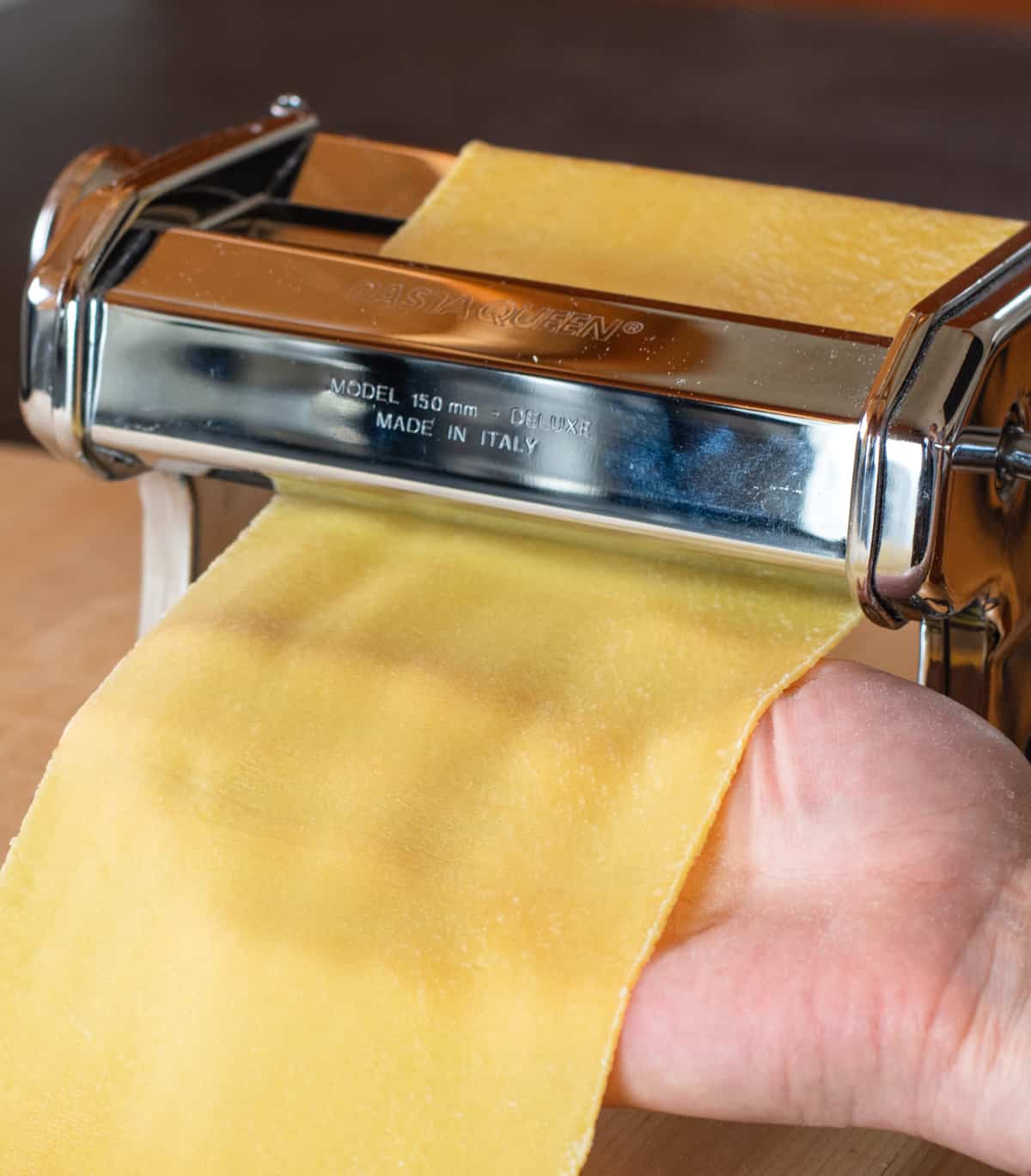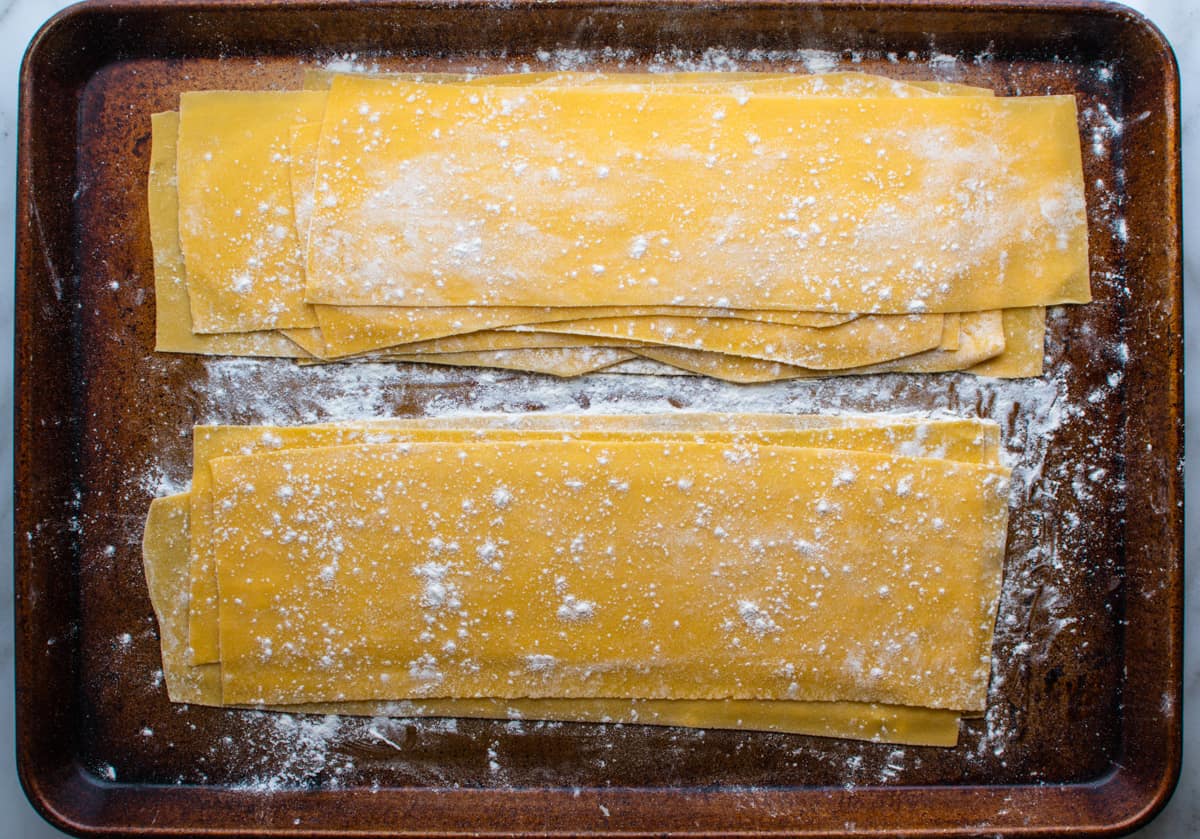This post may contain affiliate links. Please read our disclosure policy.
If you’ve never made homemade pasta, it may seem daunting, but it’s faster and easier than you might think! In less than an hour (including 30 minutes of dough resting time), you can make silky, Homemade Lasagna Noodles. Premade, store bought lasagna noodles are great for convenience, but can’t come close to the superb taste and texture of fresh noodles.

For those days when I want to serve pasta a little more noteworthy or for entertaining guests, I reach for my food processor and let it do the heavy lifting. My Food Processor Pasta Dough recipe is the fastest, easiest way I know to make a batch of fresh pasta dough. The machine does all of the mixing and kneading and requires just 4 ingredients and 5 minutes of your time (recipe below). There’s also no need to pre-boil fresh lasagna noodles, saving you even more time.
These noodles made the best lasagna! My family raved that it was the best I’ve ever made. I didn’t preboil them, so hands-on time wasn’t much longer than if I had to boil store-bought noodles and the texture of homemade is a game changer. They are so tender. I’ll never go back to messing with the slimy, rubbery store-bought ones again.
Barb
Table of Contents
Ingredients for Homemade Lasagna Noodles

- Flour: All-purpose flour.
- Salt: Kosher salt or half the amount of fine sea salt.
- Eggs: Large eggs
- Olive Oil: Ideally good, extra-virgin olive oil
Rolling Pasta Dough by Hand
A manual pasta machine makes this recipe much simpler and quicker. However, you can certainly roll the dough by hand with a good, old-fashioned rolling pin (you may even find it cathartic!). If you go this route, I recommend letting the dough rest for 1 hour instead of 30 minutes to allow the gluten to relax, which makes the dough softer and easier to work with. I use the dough resting time to prep my other lasagna ingredients.
Manual Pasta Machine Tips for Success
- As you roll the noodles thinner and longer, you’ll want to gently support dough as it emerges from the pasta machine rollers.
- Note that thickness settings vary on different pasta machines. My instructions are for an Atlas machine (here’s the one I use). Use the second-to-last setting on a manual pasta machine (on most machines, it’s #6) or 1mm thick, but double-check your machine’s instructions in case it’s different. You’ll want your noodles to be very thin, as you won’t be pre-boiling them before layering them into the lasagna.
- Use flour as necessary, but don’t overdo it as too much flour can toughen your pasta.

key Recipe Tips
- No Need to Preboil Noodles: You don’t need to pre-boil fresh lasagna noodles! Just make sure your sauce has enough moisture because the noodles will soak some up as they bake. Cover your lasagna with aluminum foil before baking to retain more moisture.
- To Preboil Noodles: If you prefer to pre-boil the noodles, cook them in two batches in a generous amount of salted water until just tender, about 1 minute. Carefully transfer cooked sheets to a colander and rinse briefly with cold water. Lay sheets flat in a single layer on clean, dry kitchen towels. Use immediately or keep covered for up to 1 hour at room temperature.
- Refrigerating Noodles: Line an airtight container with parchment paper, sprinkle with flour and arrange noodles in single layers (add parchment sheets between the layers). Seal and store in the refrigerator for up to 1 day.
- Drying Noodles: To dry your noodles, arrange them in a single layer on a lightly floured surface or clean kitchen towel. Let them stand at room temperature for 12 to 24 hours, depending on the humidity and temperature of your kitchen. (A fan set to low speed directed at the noodles will speed up this process.) You know it’s adequately dried when a noodle snaps instead of bends. Dried fresh pasta will last 2 months or more when stored in an airtight container at room temperature.
- Freezing Noodles: You can freeze noodles for up to one month. To do so, arrange them in single layers separated by parchment paper on a parchment-lined, lightly floured baking sheet and freeze for up to one month. Thaw pasta for several hours in the refrigerator before using.
- For more tips on making, drying and freezing pasta dough, see my Food Processor Pasta Dough recipe!
Lasagna is arguably the king of comfort food and one of the heartiest dishes in the Italian pasta repertoire. The layered, cheesy dish dates back to the Middle Ages in Naples, so every time you make lasagna, you’re part of the stacked dish’s history! I love lasagna for its incredible flexibility — I can customize it in endless ways to meet almost any dietary needs or food preferences. Using fresh, easy-to-make homemade noodles increases its appeal.
More Must-Try Italian Pastas
How to Make Lasagna Noodles
Step 1: Pulse flour and salt together in food processor bowl then add egg and oil mixture and pulse until there is no dry flour. Process about 1 minute, or until mixture gathers up into a ball and breaks up a couple more times. Turn the machine off and gather the dough into a smooth ball with your hands. Cover with plastic wrap and let rest at room temperature for 30-60 minutes.





Step 2: Divide fresh pasta dough into 6 equal pieces. Roll one piece a few times at the thickest setting, feeding the narrow edge through and folding into thirds as you would a letter between rolls for crisp, straight edges. Then roll one setting at a time until you reach the second thinnest setting (likely #6). Cut noodles to desired length and place in a single layer on a lightly floured baking sheet. Repeat with remaining dough (be sure to dust noodles with enough flour between layers so they don’t stick together).






Step 2: Assemble your lasagna right away or store noodles as directed above.

Homemade Lasagna Noodles

Video
Ingredients
- 2 cups all-purpose flour 272g
- 1 teaspoon kosher salt
- 3 large eggs
- 1 tablespoon olive oil
Instructions
- Add flour and salt to the bowl of a food processor; pulse a few times to combine.
- In a medium bowl, mix eggs and olive oil with a fork until just combined. Pour over flour mixture in food processor. Pulse several times until no dry flour remains. Process for about 1 minute, or until dough has gathered into a ball then broken into bead-like fragments and gathered into once or twice more. (This will both mix and knead the pasta dough.) If the dough gets stuck at any time, turn off the food processor and nudge the dough slightly and continue to process.
- Remove the pasta dough from the food processor and shape with your hands into a smooth small and cover with plastic wrap. Let rest for 30 minutes or up to 1 hour at room temperature (the longer it rests, the softer and easier to work with it will be). (Roll out immediately or refrigerate for up to 1 day.)
- Dust a rimmed baking sheet generously with flour.
- Divide dough into six equal pieces on floured work surface and cover five pieces loosely with plastic wrap. With your palm, flatten one piece into a rough rectangle about 1/2-inch thick; rub all over with flour. Feed one end through a manual pasta machine, beginning at the widest / lowest setting (1). Fold rolled dough into thirds, as you would a letter and roll it through again, feeding the narrow end through the machine; repeat this folding / rolling process three times, dusting with flour as needed.
- Now you'll run the dough through progressively narrowing settings without folding. Turn dial to the next setting (2) and, feeding the narrow side first, run dough through again. Repeat at the next four settings (3, 4, 5, 6), stopping on the second to last setting. (For a shorter noodle, cut the dough in half crosswise before running through the pasta cutter.) Cut noodle into 2 equal pieces or your desired length and place in a single layer on prepared baking sheet. Lightly dust with flour. Repeat with remaining dough portions.
- Use noodles in your favorite lasagna recipe!
To Cook Noodles (Optional)
- Cook fresh lasagna noodles in two batches in a generous amount of salted water until just tender, about 1 minute. Carefully transfer cooked sheets to colander and rinse briefly with cold water. Lay sheets flat in a single layer on clean, dry kitchen towels. Use immediately or keep covered for up to 1 hour at room temperature.
To Freeze Noodles
- Arrange in single layers separated by parchment paper on a parchment lined, lightly floured baking sheet and freeze for up to one month. Thaw pasta for several hours in refrigerator before using.
Notes
- Here is the manual pasta machine I recommend. I’ve had mine for a couple of decades and it still works beautifully.
- As with all fresh pasta, the dough will start to oxidize and turn a green / gray if left in the refrigerator for more than 1 day. So be sure to make the noodles and use or freeze before then, as directed in the post.
- This recipe serves 10-12 if you’re making a lasagna in a standard 9 x 13 x 3 baking dish.
Nutrition
Nutrition information is automatically calculated, so should only be used as an approximation.


















So easy, delicious, and versatile!
I’m so glad you’re enjoying these!
Want to try this very basic sounding recipe doing all the preparations by hand, as I have had good success making other types of homemade pasta that way. Somehow though, I’ve always bought packaged lasagna noodles but now conclude I can just try doing them the same way I do something called “kluski”. My grandmother made them all the time and I learned from her how to prepare the dough and then roll by hand before cutting into long strips, stacking them and slicing across very thinly. I’m sure using this method works in order to make lasagne noodles as well. I do like working the dough by hand so I’ll try it. Looking forward!
That’s wonderful, Catherine! I’d love to hear how it goes.
How many lasagna noodles does this make? Do you need to cut them to keep at a uniform size before drying?
Thank you for the recipe. I look forward to making the noodles soon for a family member.
Hi Georgianne! This recipe should make enough noodles for making a lasagna in a standard 9 x 13 x 3 baking dish. You can cut the noodles to fit lengthwise or crosswise and you may end up with a few odd sized noodles that still work just fine for layering. Yes, I do recommend cutting the noodles to your desired length before drying.
great. made them last night, i did not pre boil them and it worked perfectly 🙂 ty
i rested an hour and rolled by hand, super easy
That’s fantastic, Sun! So glad these were a hit.
Very Easy! Only used the “5” setting as the 6 was way too thin. Nice dough to work with.
I’m so glad you’re enjoying the recipe, Lou Ann!